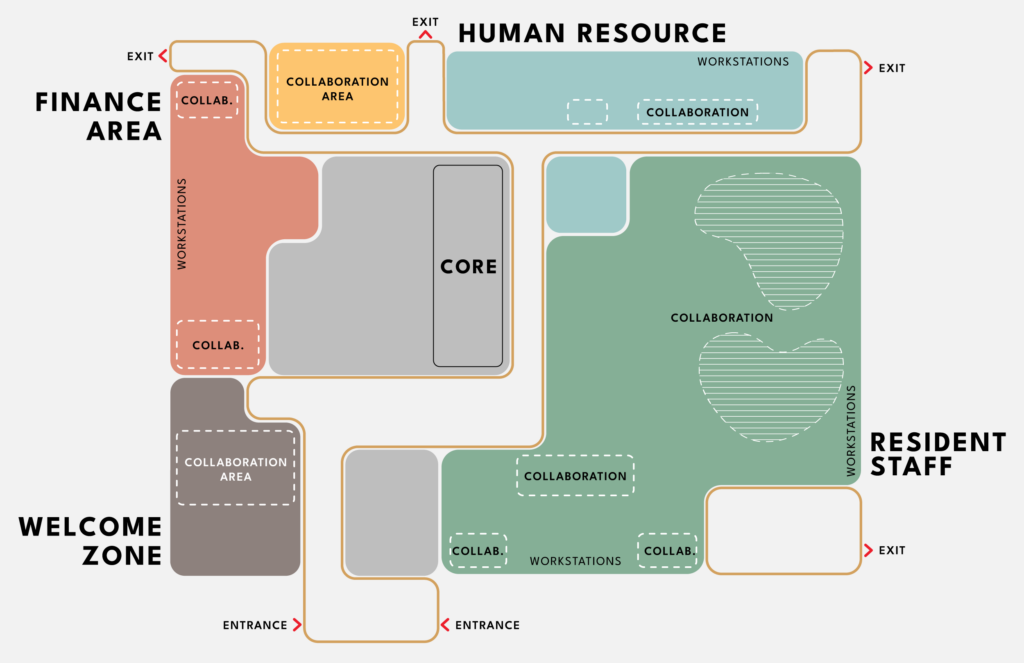Nearly all organizations have at least some workplace component, providing space for employees to work, collaborate, and socialize. These administrative environments have become a subject of great interest to employers in recent years with the realization that most workplaces, in fact, do not effectively support staff – and that this deficiency can hinder an organization’s ability to perform, innovate, build culture, and retain talent. When people feel unable to focus or collaborate, or feel ergonomic or environmental discomfort, or that they are not provided with the proper tools to work efficiently, it can deflate their level of engagement and motivation to excel.
The workplace entered a new era with COVID-19, which forced organizations worldwide into a virtual working pilot project. This shift demonstrated that remote work is a viable option, offering flexibility to employees, space efficiencies to employers, and maintaining equivalent productivity. For instance, during this time, Architecture Counsel (ACi) embarked on the Future of Work (FoW) pilot building for George Brown College. In this new hybrid reality, traditional assumptions about the workplace are being dismantled as businesses and institutions rethink what the future of work looks like. At the very least, it has given us the opportunity to re-evaluate where work best takes place.
A workplace strategy consists of a deep investigation into the culture and practices of an organization and assessment on how the workplace can be optimized to empower its teams and individuals to be more engaged, productive, and innovative. A core objective of a workplace strategy is to determine the appropriate space accommodations and tools to support how people work.
For example, a Human Resources counselor may need their own enclosed office to facilitate frequent, scheduled, and sensitive in-person conversations, while a financial analyst should be able to perform tasks with a workstation and dual monitor set-up at the office or remotely. Likewise, a legal team could benefit from several, small, AV-equipped meeting rooms to facilitate occasional and private in-person or virtual consultations with clients, while someone who works in the tech sector might have frequent, informal, and unscheduled huddles at a whiteboard with only two or three colleagues.

At ACi, we offer insight and solutions to workplace strategy. In working with us, a workplace strategist gathers all relevant information, including staff insight through various engagement methods, and crafts a functional space program for the workplace, along with any suitable recommendations related to environmental design, furniture and equipment, policies and etiquette, tools and technology, and work processes. Workplace strategy also extends into design development, ensuring that space planning effectively organizes the program to support neighbourhoods of reasonable scale, equitable access to daylight, and good distribution of shared spaces so that staff have immediate access to spaces that accommodate focus, privacy, collaboration, and nourishment.
Creating an effective workplace strategy will boost employee engagement and enhance an organization’s culture and performance by enabling the workplace to:
Provide Choice. People are unique and value the autonomy to work in a way that’s best for themselves. A variety of work settings (e.g., workstation, focus room, pod, library/quiet room, café, home, etc.) can satisfy a range of neurodiversity. Different personalities and life circumstances will also have an impact on employees’ preferences for a remote working frequency.
Build Community. With remote work offering effective accommodation for independent, focused tasks, the workplace is becoming a destination that prioritizes in-person collaboration and social interaction. Determining the appropriate capacity and right-sizing of meeting and amenity spaces can facilitate the activities necessary to foster a positive culture and strong sense of community.
Promote Wellbeing. People can spend a lot of their time in the workplace, and historically, office environments have not performed well at providing good air and water quality, facilities to support nourishment, access to natural daylight, space for respite, nor ergonomic, thermal, and acoustic comfort. A workplace that supports these principles can improve the health, wellness, and engagement of staff, enhancing their ability to be focused, creative, and productive.

